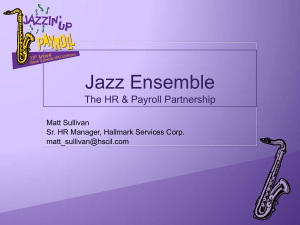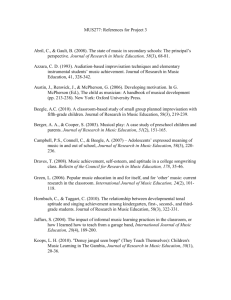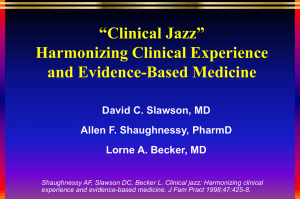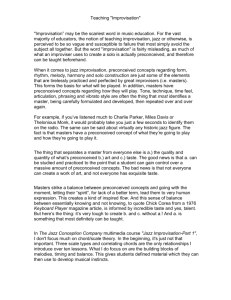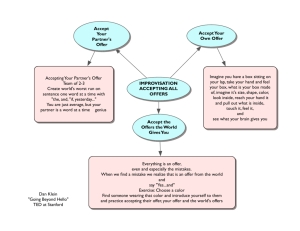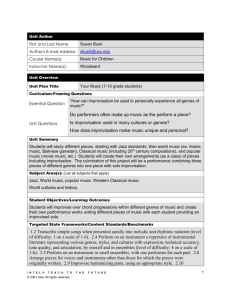Jaclyn Randazzo Lesson Plan I. Overview: The audience of this
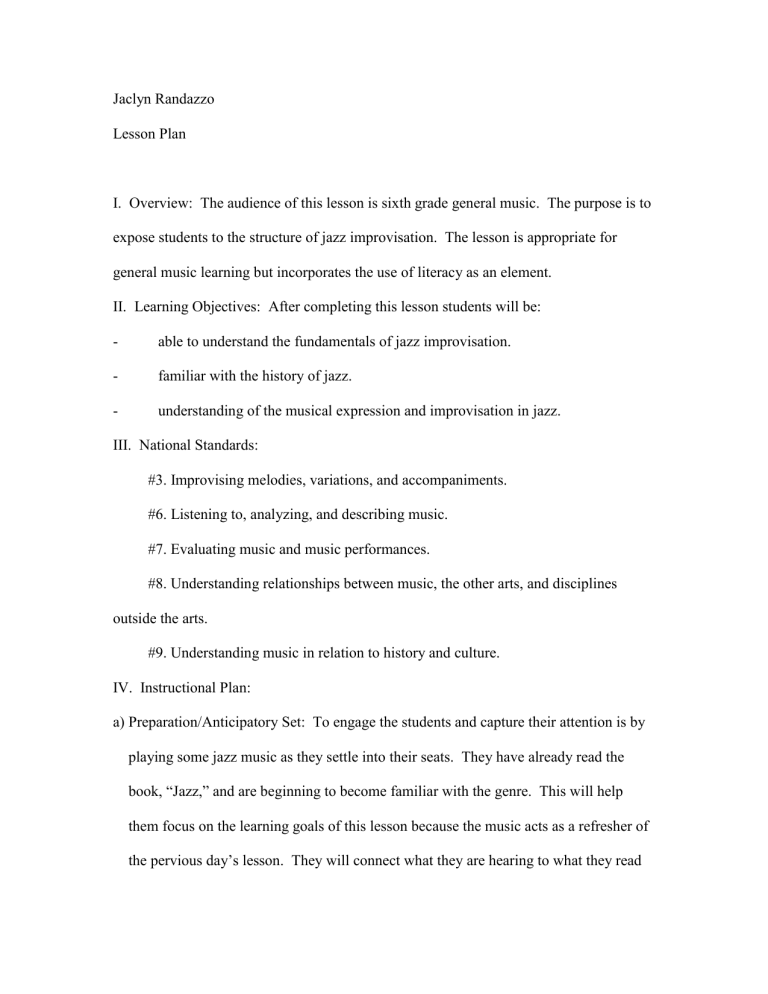
Jaclyn Randazzo
Lesson Plan
I. Overview: The audience of this lesson is sixth grade general music. The purpose is to expose students to the structure of jazz improvisation. The lesson is appropriate for general music learning but incorporates the use of literacy as an element.
II. Learning Objectives: After completing this lesson students will be:
able to understand the fundamentals of jazz improvisation.
-
familiar with the history of jazz. understanding of the musical expression and improvisation in jazz.
III. National Standards:
#3. Improvising melodies, variations, and accompaniments.
#6. Listening to, analyzing, and describing music.
#7. Evaluating music and music performances.
#8. Understanding relationships between music, the other arts, and disciplines outside the arts.
#9. Understanding music in relation to history and culture.
IV. Instructional Plan: a) Preparation/Anticipatory Set: To engage the students and capture their attention is by playing some jazz music as they settle into their seats. They have already read the book, “Jazz,” and are beginning to become familiar with the genre. This will help them focus on the learning goals of this lesson because the music acts as a refresher of the pervious day’s lesson. They will connect what they are hearing to what they read
in the book already. b) Procedure & Activities:
1.
Listen to the song and show video, “C Jam Blues,” by Duke Ellington and his famous orchestra as the students walk in. This song was written in 1942 and has
2.
3.
the typical jazz sound that the students are learning about. This gets the students into the mind frame for jazz and preps them for more of the unit.
Questions: “What words would you use to describe this song?” “Does it remind you of anything?” These questions will open the students to thinking about jazz personally. Jazz and improvisation is about self-expression. In order to have the students do improvisation, teacher needs them to be thinking about their own ideas. “Did the instruments take turns improvising?” “How did they work together?” These basic questions allow for analysis of the music and help me to understand how they are comprehending the music.
Read the “Be-bop” page of the book, “Jazz” by Walter Myers. The students have
4.
already read this book but now the focus is less on the story book itself and more about relating it personally to the students. After reading, the students will be asked to say the “screaming” part they way they see it. The font is different and therefore seems to allow for different interpretations of it. Students then can use synonyms for the word screaming as well. This allows students to open their minds and be spontaneous; the foundation of improvisation.
“Lets all start patting a steady beat.” The class will get into circle and keep a steady beat while I start improvising using my hands (clapping snapping.) We will then stop and after a little bit and teacher would ask, “What was doing?”
“Was I creating different rhythms?” “Did it go together with the steady beat you all were keeping?” Then the students will be asked to improvise over the steady beat. Teacher will point to different students and they will improvise over the steady beat until teacher tell them to stop. Students will be improvise at first by themselves and then teacher will add more to improvise together. Teacher will tell them they have to be aware of what others are doing and if it makes sense with what you are doing. The point of this activity is so students understand that
5.
improvisation is about being creative but you need to be aware of what is going on in the music to be effective.
Students will get into groups and discuss metaphors that describe jazz improvisation. Teacher will read the page, “Now I come in.” This will help them start the thought process. After they come up with a metaphor, they will physically display it by creating a song using body percussion. i) Literacy and Metaphor/Analogy Links:
Literacy instructional strategies used in this lesson are based on metaphors. The lesson calls for students to create their own metaphors about jazz improvisation. This strategy come from chapter eight, “The Incubation Stage: Hatching New Metaphors and
Analogies,” from the “Metaphors & Analogies” text. Using the book, “Jazz,” will help build vocabulary. The students have to come up with other words, besides “screaming,” to describe the melody on the “Be-bop” page. This strategy comes from the text,
“Classrooms that Work,” chapter six. The technique used is increase meaning vocabularies through reading. Within this lesson, I ask students to use words besides,
“screaming,” to describe the melody. The students must use words they know and fit the
context. All students will benefit and learn knew words and open their minds to ways of describing music using their vocabulary.
I.
Assessment:
I will know I achieved goals for students by their use of improvisation skills in the group clapping and use of metaphors for jazz improvisation along with body percussion song. The students need to understand the expression and purpose of jazz improvisation in order to come up with metaphors and vocabulary for describing melody on the “Bebop” page.
I.
Materials & Resources:
“Jazz: An American Saga” by James Lincoln Collier
“Jazz” by Walter Myers
Computer: youtube video of C Jam Blues (1942)
I.
Research Support
Panagiotis A. Kanellopoulos, “Freedom and Responsibility: The Aesthetics of Free
Musical Improvisation and Its Educational Implications- A View from Bakhtin,”
Philosophy of Music Education Review 19 (2011): 113-135.
“Yet, improvisation creates a special world of time, a time where immersion in the invention of sound structures and interaction between musicians demands their attention and creates an obligation: the obligation to be present.” This article discusses how
Bakhtinian sees improvisation as not a problem-solving method, but a “problem-positing approach.” Improvisation is freedom and an absence of fear. It’s fascinating how this article discusses how important improvisation can be a major part of music education and theoretical perspectives. The use of improvisation enhances not just musical skill but
their lives. I found this article helped me design my lesson in a creative way and helped me think about how to introduce students to the ways of jazz improvisation. I introduce it in a liberal way to open the minds of students.
Guderian Lois Veenhoven, “Music Improvisation and Composition in the General Music
Curriculum,”
General Music Today 25 (2012): 6-14.
This articles discusses the ways general music can have improvisation and composition in their curriculum. The article suggests ways of incorporating this into elementary, middle, and high school. The curriculum is based on national standards. I used this article to get ideas about how to use improvisation in this lesson and how is it standardly used.
